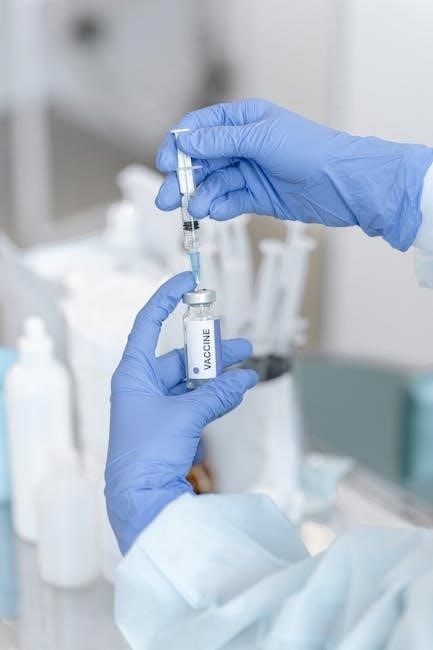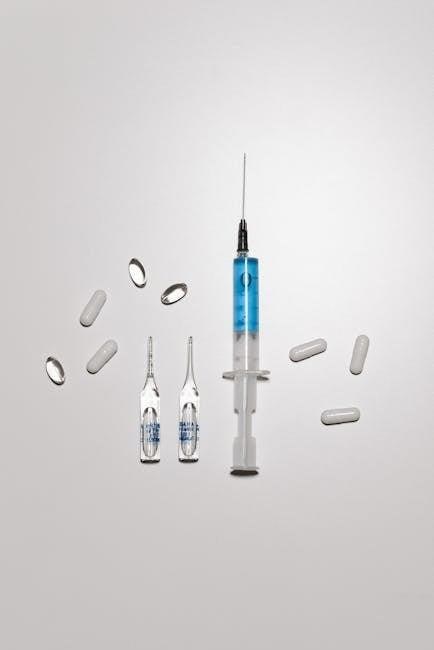Lab values are essential for nurses to assess patient health, guide care plans, and monitor treatment effectiveness. Understanding normal ranges ensures accurate interpretations and informed decisions.
1;1 Importance of Lab Values in Nursing Practice
Lab values are crucial in nursing practice as they provide objective data to guide patient care. Nurses rely on these values to confirm diagnoses, monitor treatment progress, and detect potential complications early. Accurate interpretation ensures safe medication administration and interventions. Lab results also help assess overall health, enabling nurses to prioritize care and educate patients effectively. Regular monitoring of lab values is essential for maintaining patient safety and achieving optimal health outcomes.
1.2 Overview of Common Lab Tests and Their Significance
Common lab tests include complete blood counts, basic metabolic panels, and liver function tests. These tests provide critical insights into a patient’s health status. Blood counts assess anemia, infection, or bleeding risks. Metabolic panels evaluate kidney function, glucose levels, and electrolyte balance. Liver tests detect injury or disease, guiding further diagnostics and treatment. Understanding these tests helps nurses identify abnormalities, correlate symptoms, and tailor care plans effectively, ensuring comprehensive patient management and improved outcomes.

Normal Hematology Values
Normal hematology values include RBC, WBC, hemoglobin, hematocrit, and platelet counts. These measurements help assess oxygen-carrying capacity, infection risk, and bleeding tendencies in patients.
2.1 Red Blood Cell (RBC) and White Blood Cell (WBC) Counts
RBC counts measure red blood cells, essential for oxygen transport. Normal ranges for adults are approximately 4.2-5.9 million cells/µL for men and 3.6-5.0 million cells/µL for women. WBC counts, indicating immune response, typically range from 4,000 to 10,000 cells/µL. Elevated WBCs may signal infection or inflammation, while low levels could indicate immune suppression or bone marrow issues. Accurate interpretation of these values aids in diagnosing anemia, infections, and other conditions, guiding targeted nursing interventions and care plans.
2.2 Hemoglobin, Hematocrit, and Platelet Levels
Hemoglobin measures oxygen-carrying capacity, with normal ranges approximately 13.5-17.5 g/dL for men and 12-15.5 g/dL for women. Hematocrit, the proportion of blood volume occupied by RBCs, typically ranges from 36%-48% for men and 33%-44% for women. Platelet levels, essential for clotting, normally range from 150,000 to 450,000/µL. Elevated hemoglobin or hematocrit may indicate dehydration or polycythemia, while low levels suggest anemia. Abnormal platelet counts can signal bleeding disorders or thrombotic risks, requiring prompt nursing interventions to ensure patient safety and proper management.

Blood Chemistry and Clinical Assessments
Blood chemistry tests evaluate organ function, glucose levels, and electrolytes, guiding diagnosis and treatment. Key components include renal function, liver enzymes, and lipid profiles for comprehensive patient care.
3.1 Glucose, Electrolytes, and Renal Function Tests
Glucose levels indicate blood sugar control, crucial for diabetes management. Electrolytes like sodium, potassium, and chloride maintain fluid balance and nerve function. Renal function tests, including creatinine and BUN, assess kidney health, guiding interventions for conditions like acute kidney injury or chronic kidney disease.
3.2 Liver Enzymes and Lipid Profiles
Liver enzymes, such as ALT and AST, help assess hepatic health. Elevated levels may indicate liver damage or disease. Lipid profiles, including cholesterol and triglycerides, are crucial for evaluating cardiovascular risk. Nurses monitor these values to guide treatment, such as adjusting medications or recommending lifestyle changes to improve patient outcomes and reduce complications.

Urinalysis and Urine Tests
Urinalysis evaluates urine components, including protein, blood, and glucose, to assess kidney function and detect conditions like diabetes or infections. Essential for early diagnosis and monitoring.
4.1 Normal Urinalysis Values and Abnormal Findings
Normal urinalysis values typically show clear to straw-colored urine with specific gravity 1.002-1.035. Protein, blood, and glucose are usually absent or within trace limits. Abnormal findings include hematuria, proteinuria, or glucosuria, indicating potential kidney issues, diabetes, or infections. Nurses must recognize these deviations to identify conditions early and facilitate timely interventions. Proper interpretation ensures accurate diagnosis and effective patient care. Regular monitoring helps track changes and assess treatment responses. Understanding these values is critical for nursing practice and patient outcomes.
4.2 Protein, Blood, and Glucose in Urine

Protein in urine is typically minimal, with normal levels ≤150 mg/24 hours. Trace amounts are common, but higher levels may indicate kidney damage or disease. Blood in urine (hematuria) is abnormal and could signal infections, stones, or inflammation. Glucose is usually absent, as kidneys reabsorb it; its presence (glucosuria) often points to diabetes or renal issues. Nurses must recognize these findings to identify potential conditions early. Monitoring these elements helps in diagnosing and managing urinary and systemic disorders effectively.

Interpretation of Lab Results for Nursing Practice
Understanding lab results is crucial for nurses to identify normal and abnormal values, guiding patient care decisions and ensuring timely interventions for optimal outcomes.

5.1 Understanding Normal and Abnormal Ranges
Accurate interpretation of lab results begins with recognizing normal and abnormal ranges. Normal ranges vary by lab and population, while abnormal values signal potential health issues. Nurses must understand reference ranges for tests like CBC, electrolytes, and liver enzymes to identify deviations. For example, elevated WBCs may indicate infection, while low hemoglobin suggests anemia. Recognizing these patterns helps nurses correlate lab data with clinical symptoms, ensuring timely interventions and improving patient outcomes. This skill is critical for effective care planning and communication with healthcare teams.
5.2 Correlating Lab Results with Patient Symptoms
Correlating lab results with patient symptoms is vital for accurate diagnosis and care. For instance, low hemoglobin levels paired with fatigue or pale skin suggest anemia. Elevated WBCs alongside fever or chills indicate infection. Nurses must analyze lab data in the context of clinical presentation to identify patterns. This integration helps prioritize interventions, rule out differential diagnoses, and tailor care plans. Effective correlation enhances patient outcomes by ensuring timely and targeted treatments. It also supports clear communication with healthcare teams, fostering a collaborative approach to patient management.

Application of Lab Values in Nursing Care
Lab values guide nursing care by monitoring treatment effectiveness, adjusting interventions, and educating patients, ensuring personalized and evidence-based care plans that improve patient outcomes.
6.1 Monitoring and Adjusting Treatments Based on Lab Results
Lab results are crucial for guiding treatment adjustments, ensuring personalized care. Nurses monitor trends in values like blood glucose or electrolytes to assess therapy effectiveness. For instance, elevated creatinine levels may signal the need for medication dose adjustments. Regular lab assessments help identify potential complications early, allowing timely interventions. This iterative process ensures treatments remain aligned with patient needs, improving outcomes and minimizing adverse effects. Accurate interpretation and timely action are key to optimizing care plans and enhancing patient safety.
6.2 Patient Education and Communication of Lab Findings
Effective communication of lab results is vital for patient understanding and engagement in care. Nurses play a key role in explaining findings in simple terms, addressing concerns, and linking results to treatment plans. Using visual aids like charts or PDF guides can enhance comprehension. Clear communication ensures patients understand abnormal results, lifestyle modifications, or medication adjustments. Nurses also empower patients to ask questions, fostering trust and adherence to care plans. This collaborative approach improves health outcomes and patient satisfaction, making lab education a cornerstone of nursing practice.

Resources for Nurses
Nurses can access various resources, including printable charts and digital tools, to quickly reference and interpret lab values, ensuring accurate care and decision-making.
7.1 Printable Lab Value Charts and Guides
Printable lab value charts and guides provide nurses with quick, portable references for normal ranges and test interpretations. These resources are ideal for nursing students and professionals, offering concise information on blood chemistry, hematology, and urinalysis values. Many charts are available as downloadable PDFs, such as the “Normal Lab ValuesLab Cheasheet for Nursing Students” and “NCLEX Pharmacology AudioLearn.” They often include test names, abbreviations, and normal ranges, making them indispensable tools for clinical practice and exam preparation. These guides ensure accuracy and efficiency in patient care.
7.2 Recommended PDFs and Apps for Lab Value Reference
Several PDFs and apps are highly recommended for quick lab value reference, enhancing nursing practice and education. The “Normal Lab ValuesLab Cheasheet for Nursing Students” PDF offers concise, portable information. Apps like the “Lab Values Guide” provide interactive tools and real-time updates. These resources are invaluable for nurses, enabling rapid access to normal ranges, test interpretations, and clinical correlations. They support both student learning and professional decision-making, ensuring accurate and efficient patient care. These tools are essential for staying updated on lab value standards and interpretations.

